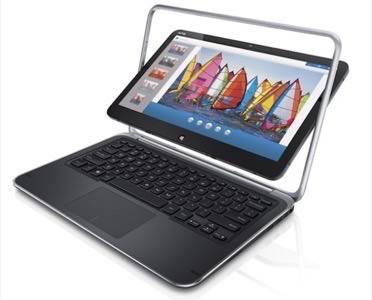
The launch of Windows 8 may still be two months away, but the tide of new hardware releases is beginning to swell – including hybrid notebook/tablet devices from Dell and Samsung.
HP just announced a convertible Windows 8 notbook tablet (see HP Envy x2 Tablet/Laptop Combo Cuts Across Categories), while Dell used the IFA show in Germany to announce its first Windows RT device as well as a convertible notebook/tablet.
Not quite a convertible, Samsung debuted its Series X5 ultrabook, which looks exactly the same as the previous model, but adds a capacitive touch screen to the 13.3-inch display. Lenovo also debuted a series of Android tablets – including one with a detachable keyboard, following its earlier launch of the ThinkPad Tablet 2.
The message? Windows 8 is making touch more important than ever, and is driving a move toward tablets and convertibles that combine an ultrabook with touchscreen functionality to be both content creation and consumption devices.

Samsung
Take the new Series 5 notebook from Samsung. Like its rivals, the new Series 5 will be released about the time of Windows 8, on Oct. 26. Starting at $799 with an Intel Core i5 processor, the real innovation is adding touch to the notebook screen to take advantage of Windows 8’s new user interface. But Samsung also said that those who don’t love the new Modern UI, (formerly known as “Metro”) will also be able to take advantage of a proprietary widget that replicates the “Start” button and control panel familiar from Windows 7 and Vista.
Dell
Dells new products include the XPS 10 (a 10-inch, ARM-based tablet running Windows RT) and the XPS Duo 12 convertible.
Dell had already said it would build a a Windows RT tablet, so the XPS 10 comes as little surprise. (Others promising RT tablets include Samsung and Lenovo.) Windows RT, as you might recall, is Windows 8’s little brother, a new version of the operating system that runs on ARM processors, rather than the X86 chips that power regular Windows 8 hardware.
Unfortunately, the release of a Windows RT tablet didn’t offer any peeks at the mysterious Windows RT operating system. But that wasn’t the case. The the XPS 10 was released under glass, blocking efforts to explore the interface, and how apps interacted with the RT interface. So we still don’t really know whether you should buy Windows 8 or Windows RT.
Dell also didn’t release the price of the XPS 10, the other major question surrounding Windows RT tablets.

Convertibles Are Hot
Given the launch of the rival HP Envy X2 a day ago, however, it seems fair to say that PC makers believe convertible ultrabook/tablets will be the most popular new form factor.
Both the Envy X2 and the XPS Duo 12 combine a tablet with a keyboard unit that allows them to function as either a tablet or a notebook computer. The two aren’t exactly alike, however; the Envy X2 actually includes a detachable tablet, while the Duo 12 simply uses a screen that flips back and forth on a hinge, tucking the keyboard behind it.
Dell isn’t commenting on the exact specifications, even whether or not the “12” stands for a 12-inch display. The company did say in a press release that the tablet supports full HD resolution, however, and uses Corning’s Gorilla Glass for toughness.
“We haven’t disclosed full specs on the XPS Duo 12 and will be providing further info as we get closer to availability,” a Dell spokeswoman said in an email. “It does meet the Ultrabook specifications, so is based on Intel technology, and will run Windows 8.”
Dell clearly designed both the XPS 10 and the Duo 12 as devices that could be brought from home into an enterprise environment. “The XPS 10, XPS Duo 12 and XPS One 27 represent the culmination of a deep understanding of the ‘Bring Your Own Device’ movement and insights gained from both our consumer and business customers,” said Sam Burd, global vice president, PC product group at Dell, in a statement.
That combination of business and consumer uses is what Microsoft hopes will be Windows 8’s special sauce in a wide variety of devices including Microsoft’s own Surface. And it now looks like there will be plenty of choices in this new cross-over genre.
Of course, Microsoft isn’t the only company hoping to ride the convertible bandwagon: Lenovo introduced the S2110, a 10.1-inch tablet that can plug into an optional keyboard dock that gives it a 20-hour battery life. It includes both 16 GB and 32-GB storage options.


















